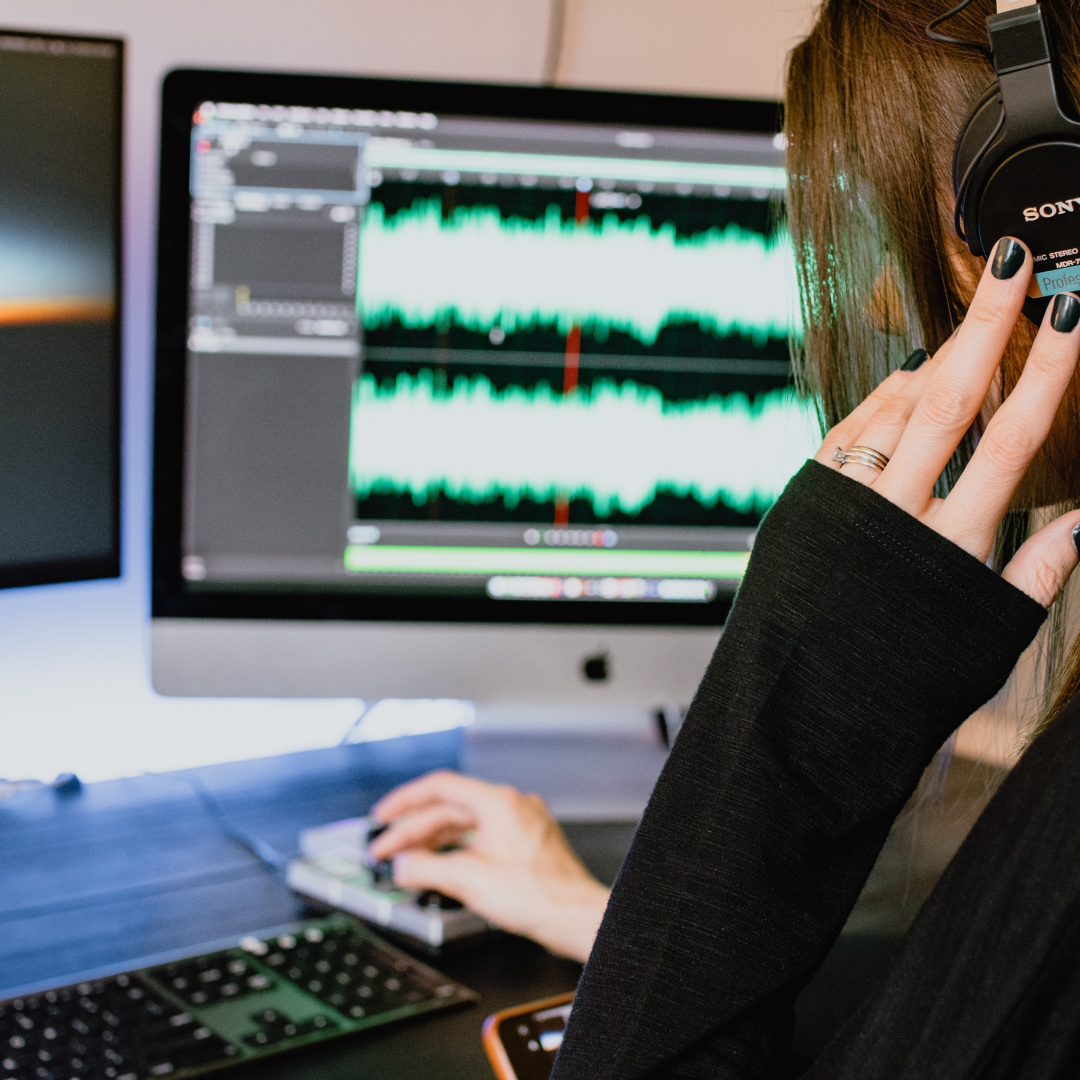After you’ve recorded your podcast on SquadCast, you’re given the choice of downloading it as one of two audio file formats: WAV or MP3. (And WebM and MP4, but those are for video.)
Each format comes with pros and cons, but which is the right format for you also depends on factors including how much editing you plan to do on your podcast, what kind of podcast you’re making, and how fussy you are about audio quality.
However, choosing between the WAV file format vs MP3 doesn’t require a degree in audio technology. No, seriously.
The short version of which one to pick is: Download and edit in WAV, then convert to MP3 for distribution.
The slightly longer version is that MP3s are compressed audio files: They’ve been squished down to make them take up less storage space. WAV files are uncompressed files: They contain all the digital information your recording could pick up, without sacrificing any data.
See, easy! If you want the much longer answer on the differences between MP3 and WAV, and how to use both, read on.
What is Compressed Audio?
What are MP3 Files?
What are WAV Files?
The Battle of the Audio File Formats
Round One: Audio quality
Round 2: Storage
Round 3: Compatibility
Other Types of Audio Files
Conclusion: How Podcasters Should Think About MP3 vs WAV File Formats
What is Compressed Audio?

To understand the key differences between MP3 and WAV files, you need to understand a little bit about how audio is captured digitally.
Imagine you’re playing a guitar. The music you’re making is represented as a sound wave, like the ones you probably learned about in school. Microphones take that analog sound and turn it into a digital representation that can be read by a computer, by identifying points on that wave.
The more points that can be identified, the more information the computer has to draw on when building its representation of the sound. If you only know where the wave began and ended, for example, the computer will have to guess what happened in between.
In a compressed format like an MP3, some of those points (known as bits) are sacrificed to make the file size smaller. In contrast, WAV is a lossless format: You don’t lose as many bits.
Here’s another analogy, in case physics wasn’t your thing. Remember those dot-to-dot puzzles you used to do as a kid? You’d start at the dot labeled one, then connect it with a straight line to the dot labeled two, then that one goes to three etc., until you have a picture.
If that dot-to-dot picture was stored as a WAV, it would have more numbers and shorter gaps between each consecutive number than a dot-to-dot picture stored as an MP3. That means there’s less chance of going wrong with a WAV, because your line only has to go a short distance. You’re less likely to wobble or veer off course, compared to drawing a long line.
The final image you drew would also be more detailed. Whereas a WAV might use, say, numbers one through 100 to draw an elephant face, MP3s might only use 20. An elephant made up of 20 dots joined by lines will look less realistic than one where you have 100 points to reference.
Given all this, you may be wondering, why wouldn’t everyone just use WAV for everything? We’ll get to that in a bit (pun intended.)
What are MP3 Files?
By now you know that MP3 files, unlike WAVs, are compressed files. They drop some of those bits that tell the computer what to play, and that means they don’t take up as much space. This sacrifice of data is why MP3s are described as a lossy format. (Rude.)
However, that’s not necessarily a death knell for the MP3. That compression is actually the format’s greatest strength as well as its biggest flaw.
What are WAV Files?
You also know by now that WAV files are an uncompressed format. Unlike MP3 files, WAV files don’t surrender any of that precious data for the sake of file size. And that’s why WAVs are considered a lossless format.
No loss means you only gain with WAV, right? In theory — but it’s possible to have too much information.
Fun fact about the WAV format: This audio format was created by computer giants Microsoft and IBM as an alternative audio format to avoid lossy compression files for PCs.
The Battle of the Audio File Formats
Now we have a basic understanding of the key differences between MP3 and WAV files, let’s see how they stack up against each other for podcasters.
Round One: Audio quality
WAV files win every time when it comes to the quality of the sound. When a digital recording of an analogue sound is stored and played as a WAV, the computer doesn’t have as many gaps between data points to guess at. This means the digital sound is closer to the live sound.
It’s also cleaner. When computers play compressed files, they don’t just lose quality in between those data points, sometimes they introduce something called compression artifacts: distortions that sound like hissing or ringing.
This distinction is why WAV files are the standard format used by audio editors. With WAV files, editors get a clearer picture of what’s happening at every point along a sound wave. It’s the difference between looking at a sample on a slide with your bare eyes, and putting it under a microscope. The more you can see, the more you can understand how small sections make up the whole, and move them around.
With all that said, most listeners can’t hear the differences between WAV files and MP3 files, especially when you’re talking about podcasts. The quality loss is more recognizable when you listen to music, but even then, most people have to teach themselves to hear it. Which seems like a good way to drive yourself mad every time your favorite song comes on over a tinny store sound system.
Given this sudden twist in the tale, it’s perhaps becoming clearer why MP3s, and not WAVs, have become the preferred format for podcasters. The following rounds will make that even more understandable.
Know this: WAVs are on top when it comes to delivering cleaner, more accurate sound — but most people can’t even tell the difference.
Round 2: Storage
MP3 files are between five and 10x smaller than WAV files, which means they take up less space on your storage device. That’s the whole point of compressed files!
There are a few benefits of using smaller files:
- Pay less to store your audio. Some hosting platforms, including Libsyn, charge you more based on how many megabytes (MB) of content you upload per month. This can really add up if you make long or regular episodes. Choosing MP3s over WAVs could mean you’re able to go with a cheaper plan. The same goes if you’re storing copies of your audio files on cloud-based hosting services like Dropbox, although these tend to be less stingy about storage allowances.
- Listeners typically prefer smaller files. Yes, you will get the audio nerds who swear they can tell the difference between a WAV and an MP3 just by listening. But most podcast listeners will always choose smaller file sizes over barely audible sound quality differences, because it means they’re able to fit more episodes onto their devices without taking up space needed by other apps. Storing lots of large files can also slow down processing speed, which is more likely to annoy your listeners than the occasional audio malfunction.
Know this: If you want to cram more audio onto the cloud and into your listeners’ devices, MP3 files win hands down.
Round 3: Compatibility
Once you’ve put all that time and effort into making your show, you want to be sure that you can reach as many people as you can. So you need a format that works with as many devices and podcast apps as possible. Which would be MP3s.
For a long time, MP3s have been the default audio file type in podcast distribution. Pretty much every single device anyone could ever hope to use to play a podcast supports MP3s. Some apps won’t take anything other than MP3 files: Notably, Apple Podcasts won’t accept WAV files from RSS feeds.
So although WAVs are becoming more common, if you want to avoid being penalized over your audio file format by listeners’ devices or podcast apps, MP3 is a safer bet.
Outcome: MP3 is the long-accepted standard podcast audio file, and is compatible with most devices and apps. But WAVs are catching up.

Other Types of Audio Files
MP3 and WAV formats are just two types of audio formats. You might also have heard about AAC, FLAC or ALAC. Here’s a quick lowdown on those.
What are AAC files?
If you spent a lot of time and money in iTunes (RIP), you may remember that AAC files were the default audio format of the songs you purchased — albeit in a protected version (thanks Apple.)
The acronym stands for Advanced Audio Coding, which summarizes what this audio format was created to do. AACs use complex compression algorithms to reduce the size of audio files, while still maintaining a higher audio quality than MP3s.
Today, this audio format is used by YouTube, and may one day take over as the most popular audio file format, if you believe some people. However, MP3s remain the most prevalent audio format right now.
What are FLAC and ALAC audio formats?
Now you’re getting super nerdy. FLAC (Free Lossless Audio Codec) is a lossless format that reduces the size of the audio file without sacrificing sound quality. It does so by targeting and removing redundant information, while preserving useful audio data. FLAC doesn’t work with iOS: ALAC (Apple Lossless Audio Codec) is Apple’s version of this format.
In theory, FLAC or ALAC would be an excellent format for your podcast files. Except they are still pretty obscure at this point, and are more typically used for digital music.
MPEG vs MP4 vs MP3
When you’ve finished your SquadCast recording, one of the file formats you have the option of downloading is an MP4. You may also have seen the term MPEG around, and wondered whether MP4s are the next edition of MP3s.
These formats actually serve entirely different purposes. The difference between MPEG vs MP4 vs MP3 is easier to clear up — at the top level at least — than the other file formats in this article. Simply, if you see MPEG or MP4 after a file name, the file is a video, whereas MP3 is only for audio.
MP3s and MP4s were created by the Moving Picture Experts Group (MPEG). But MPEG is also the name of the file extension for MPEG Video files. MP4 is the file extension for MPEG-4 Video File. So while all MP4s and MP3s are MPEGs, not all MPEGs are MP4s or MP3s.
In short, you only need the MP4 if you’re planning to release your podcast as a video.
Final Thoughts: How Podcasters Should Think About MP3 vs WAV File Formats
 If you’ve made it all the way down here, you already know the answer to this. There’s a reason MP3 became the default file format in the audio world, accepted by most devices and preferred by podcast services.
If you’ve made it all the way down here, you already know the answer to this. There’s a reason MP3 became the default file format in the audio world, accepted by most devices and preferred by podcast services.
MP3s are compressed, lossy files that sacrifice digital audio data and therefore sound quality for a smaller file size. In contrast, WAVs are uncompressed audio files that retain more data points and therefore offer uncompromised audio quality.
Instead of pitching WAVs against MP3s, it’s better to think about how each file format works better for different stages of the podcasting process.
If you’re planning to edit your recording, you should definitely download and open it as a WAV file. You’ll have more data points to pull from, which will make it easier to get a clean, detailed edit.
Once you’ve got your episode ready, convert it to an MP3 for distribution. If you can’t do this in your podcast editing software, you should be able to do it freely and easily on another platform.
If you aren’t planning to edit, you can download the MP3 version straight from SquadCast.
It’s at the distribution stage that the MP3 format becomes preferable.
Even though WAVs technically offer a better sound quality, the differences are hardly noticeable to most listeners, especially when it comes to spoken word audio. And the significantly smaller size of MP3s means they take up less storage space on devices and in the cloud. Also, MP3s are compatible with most podcast apps and devices, whereas some providers are behind on WAVs.
Despite all this, some podcasters might still prefer to stick with the WAV format all the way through, especially if you’re playing music or are one of those people blessed or cursed with the ability to hear the difference in sound quality.
At least now you know what’s the right format for you — no degree in audio tech required!
Zachariah Moreno is the co-founder, CEO, & CTO of SquadCast. He is also a podcaster, author, developer, and designer. He and his team are on a mission to amplify collaboration.
